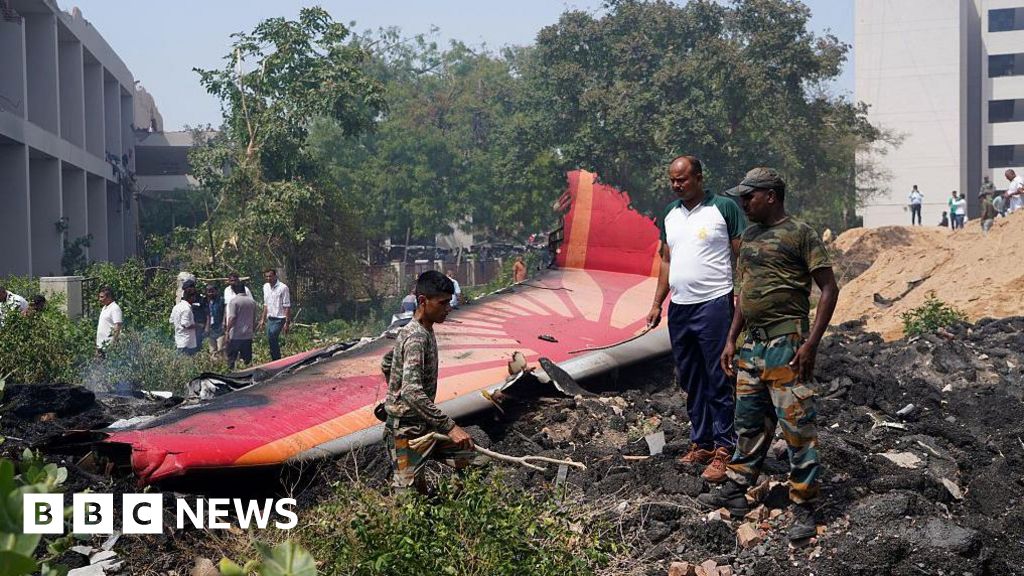
Air India Crash Breakthrough: Black Box Data Unveils Deadly Flight’s Final Moments 🌍✈️
What if the deadliest air disaster in modern Indian history isn’t just a tragedy, but a turning point in aviation safety and accountability? On June 12, 2025, an Air India Boeing 787 Dreamliner bound for London crashed moments after takeoff from Ahmedabad, killing 241 passengers and crew, and leaving 242 people dead in total. Now, Indian investigators have successfully retrieved and downloaded the flight data recorders—crucial black box data that could unravel the mystery of the crash. This breakthrough, celebrated as a major step in understanding aviation disasters, has reignited global conversations about flight safety, technological preparedness, and the role of black box data in holding airlines and regulators accountable.
The crash, which occurred in one of the busiest airports in India’s western region, has created a public outcry and raised urgent questions about the safety protocols in place. While the exact cause remains under investigation, the successful retrieval of black box data from the Boeing 787-8 Dreamliner marks the first major milestone in the process of determining whether technical failures, human error, or external factors were responsible for the tragedy. For aviation experts, the release of this data represents a critical opportunity to learn from the incident and implement life-saving measures. However, the emotional toll on the victims’ families and the political implications of the crash underscore the broader challenges of air safety in an era of rapidly evolving technology and global scrutiny.
This tragedy is not just a local issue; it has become a global conversation about how modern aviation systems are prepared for emergencies. The Boeing 787’s advanced features, including its flight data recorders, are designed to provide the most detailed insights into a plane’s final moments. Yet, even with these innovations, the crash highlights persistent vulnerabilities in aviation safety, from inadequate maintenance protocols to unforeseen mechanical failures. The Air India incident also raises concerns about the reliability of real-time monitoring systems and the need for stricter oversight in the wake of such a disaster. As the AAIB (Aircraft Accident Investigation Bureau) works on piecing together the black box data, the world watches closely to learn from this catastrophic event.
The Black Box Breakthrough: A Critical Step Toward Understanding the Disaster
The retrieval of black box data from the Air India crash has provided investigators with a rare and invaluable glimpse into the aircraft’s last moments. The flight data recorder and cockpit voice recorder, which were recovered from the wreckage in Ahmedabad, have been carefully preserved and transported to the AAIB laboratory in Delhi for analysis. Indian officials confirmed that the data was successfully downloaded on June 25, 2025, marking a pivotal moment in the search for answers. This breakthrough has not only helped the investigation move forward but has also sparked global interest in the role of black box data in modern aviation safety.
For aviation safety experts, the stakes of this investigation are immense. The black box data could reveal whether the crash was caused by a mechanical failure, a stall, or a human error. It could also shed light on whether the Boeing 787’s advanced systems were functioning as intended or if there were flaws in their design or maintenance. The AAIB has emphasized that the recovery of these recorders was a meticulous process, requiring specialized equipment and collaboration with international aviation authorities. The data, once decrypted and analyzed, will provide a detailed account of the aircraft’s movements, speed, altitude, and the pilots’ actions in the critical moments leading to the crash.
The significance of this breakthrough cannot be overstated. In the past, black box data recovery often took months or even years, but the swift retrieval of the recorders from the Air India crash has set a new standard for emergency response in aviation. This highlights the importance of having robust protocols in place to secure and analyze such data promptly. However, the challenge remains in interpreting the black box data, which is often encrypted and requires technical expertise. The AAIB, with its years of experience in investigating similar crashes, is well-equipped to tackle this process, but the depth of the findings will determine the next steps in improving flight safety standards worldwide.
Eyewitness Accounts and Technical Analysis: Unraveling the Tragedy
Eyewitness accounts from the Ahmedabad airport have provided a chilling backdrop to the investigation, with some describing the plane’s sudden departure from the runway as if it were “plucked from the sky.” Video footage from the airport captured the moments before the crash, including the plane’s takeoff and its rapid descent. While the exact sequence of events remains unclear, the black box data is expected to clarify whether the crash was the result of a technical anomaly, a pilot error, or an external factor such as air traffic control miscommunication.
Technical experts have weighed in with their analysis, noting that the Boeing 787’s design includes advanced automation and redundancy systems designed to prevent such catastrophes. However, the crash has raised questions about whether these systems failed or were overwhelmed by the conditions the aircraft faced. Some specialists suggest that the plane’s sudden stall could have been due to a combination of factors, including weather disruptions, maintenance oversights, or even systemic issues within the aviation industry. The AAIB has emphasized that the black box data is a critical component in these investigations, as it provides an objective record of the aircraft’s operations.
The lessons from the Air India crash are already being scrutinized by aviation safety organizations worldwide. The International Air Transport Association (IATA) has called for increased transparency and data-sharing mechanisms to prevent similar incidents. However, the geopolitical implications of the crash are just as profound as the technical ones. As India grapples with its aviation sector’s losses, the global community is watching closely, with many fearing that the incident may spark renewed debates about the safety standards of international airlines and the need for stricter regulations. The black box data will be instrumental in addressing these concerns and ensuring that such a tragedy does not repeat itself.
A Global Shift in Aviation Safety: Lessons from the Air India Disaster
The Air India crash has become a catalyst for a global reevaluation of aviation safety protocols, particularly in the context of modern aircraft like the Boeing 787. With the black box data now available, experts are calling for a comprehensive review of maintenance procedures, crew training, and emergency response systems. The tragedy highlights the vulnerabilities of even the most advanced planes, as the Boeing 787’s sophisticated features were not enough to prevent the disaster. The incident has also sparked discussions about the reliance on automation and the need to balance technology with human oversight in aviation.
In the wake of the crash, several global aviation news platforms have emphasized the importance of flight data recorders in tracking the root causes of such tragedies. The 2024 IATA report on aviation safety noted that the use of black box data has become a cornerstone of modern incident analysis, with over 70% of recent crashes being investigated through these critical recordings. The Air India crash, however, has added a new dimension to this conversation, as it underscores the need for increased transparency in the aviation industry. Investigations into the crash may reveal systemic issues that extend beyond a single incident, influencing future policies for global air travel.
The geopolitical ramifications of the Air India crash are also significant, particularly for India’s aviation sector and its international partnerships. As the AAIB works to determine the cause, the incident could lead to calls for stricter safety regulations, mandatory inspections for specific aircraft models, and a reevaluation of how foreign airlines operate within Indian airspace. The black box data may also serve as a precedent for other countries, prompting them to reassess their own aviation systems in light of the crash. This shift in focus is not just about safety but also about accountability, as airlines and regulatory bodies face growing pressure to ensure that incidents like this are prevented in the future.
The Human Toll and the Path Forward: A Call for Transparency and Reform
The human cost of the Air India crash is immeasurable, with 242 lives lost in a matter of minutes. For the families of the victims, the retrieval of black box data represents both a hope for answers and a painful reminder of the tragedies that can unfold in the skies. As the AAIB works to extract the data, the global aviation community is also reflecting on how such incidents can be minimized. Industry leaders have pledged to review the findings and implement changes, but the speed at which this happens will determine the legacy of the Air India crash.
The pressure on the AAIB to deliver results has been immense, with the Indian government emphasizing the need for a timely and transparent investigation. The authorities have reassured the public that the black box data will be analyzed with the utmost care, and that all findings will be shared with the families and the public. However, the challenge lies in interpreting the data accurately and ensuring that the investigation is free from political bias or external interference. The Air India crash has become a flashpoint for discussions about how aviation safety is managed, particularly in regions with complex geopolitical landscapes.
The broader implications of the crash extend beyond India, as many countries are now scrutinizing their own aviation systems for potential vulnerabilities. For example, the European Union has announced a review of its civilian aviation protocols, driven by the Air India incident. Meanwhile, the United States is examining the role of black box data in its own investigations, with the National Transportation Safety Board (NTSB) calling for increased collaboration with international agencies. The crash has already led to calls for more stringent safety measures, and the black box data may ultimately shape the future of aviation regulations worldwide.
A New Era for Flight Safety: The Role of Black Box Data in Aviation Reform
The aftermath of the Air India crash has set the stage for a new era in aviation safety, where black box data is not just a tool for investigation but a key driver of policy reform. With the data now in hand, the AAIB is expected to publish a detailed report within the next 18 months, a timeline that has drawn comparisons to previous high-profile aviation disasters. The release of this information will be crucial in determining whether the crash was a rare anomaly or a symptom of a deeper systemic issue within the global aviation industry.
International aviation experts have called for an expanded framework of data-sharing and transparency, emphasizing that the recovery and analysis of black box data must be a priority for all nations. The IATA has proposed a multi-phase approach, including the integration of artificial intelligence (AI) into the analysis of flight data, a move that could speed up the investigation and improve safety outcomes. While the technical challenges of interpreting the black box data are considerable, the potential benefits for future aviation safety are undeniable.
The Air India crash has also highlighted the need for better communication between airlines, regulatory bodies, and passengers. In an age where real-time data sharing is possible through modern technology, the delay in releasing critical information has raised concerns about transparency. As the AAIB works to provide clarity on the crash, the global aviation industry is being forced to confront its own shortcomings, including outdated maintenance protocols and insufficient pilot training. The black box data from the Air India incident may not only explain the crash but also catalyze far-reaching reforms that could prevent future tragedies.
Key Takeaways
- The retrieval of black box data from the Air India Boeing 787 crash represents a major milestone in the quest to understand aviation disasters and improve safety standards globally.
- The crash, which killed 242 people, has sparked urgent calls for transparency, accountability, and reform in the aviation industry, with experts emphasizing the need for better data-sharing mechanisms.
- While the black box data provides critical insights into the Boeing 787’s final moments, the investigation’s outcome will depend on the integrity of the process and the willingness of authorities to address systemic issues.
- The global repercussions of the Air India incident extend beyond aviation safety, influencing international regulatory frameworks and the way countries approach flight oversight.
- The balance between technological advancement and human oversight in aviation remains a critical concern, with the Air India crash serving as a stark reminder of the limitations of automation.
- As the AAIB publishes its findings, the data from the crash could shape policies that prevent similar disasters in the future, ensuring a more transparent and secure aviation landscape.
The Air India crash and the subsequent retrieval of black box data have underscored the importance of transparency and accountability in aviation. While the exact cause of the disaster remains under investigation, the process of analyzing the data will be pivotal in shaping future safety protocols and regulatory frameworks. For the families of the victims and the global aviation community, the hope is that this tragedy will lead to meaningful reforms, ensuring that the skies remain a realm of safety for all who travel. The lessons learned from this accident will not only affect how Indian airlines operate but could also redefine the standards of flight safety on a global scale.





